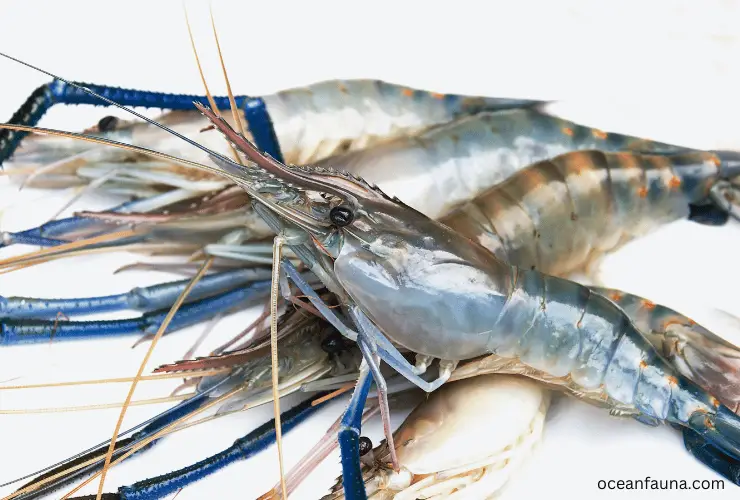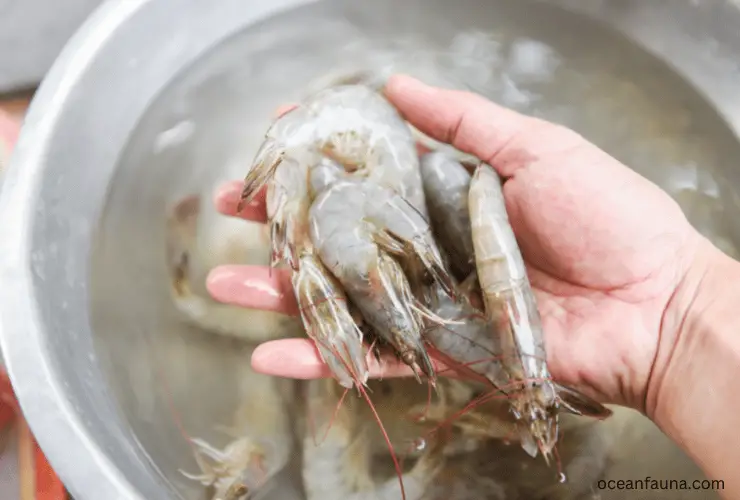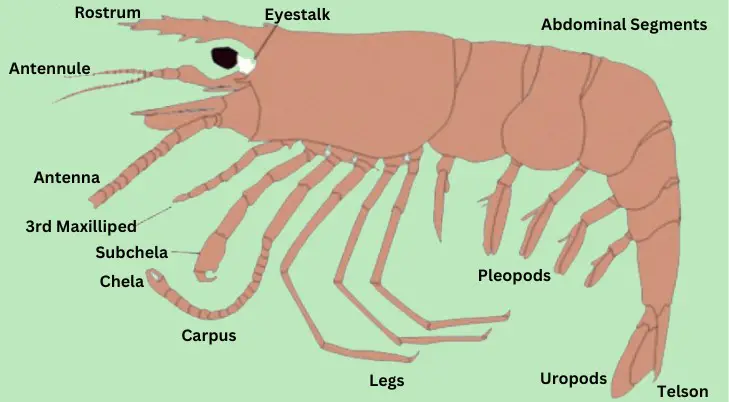Shrimps do have blood, but it’s not similar to the blood found in humans. It is called hemolymph, which has both cellular and liquid components. The cellular component consists of hemocytes, while the liquid component contains various humoral factors, which are macromolecules of the circulatory system.
In this article, I will describe the blood of shrimps, its components, and their functions in detail.
Do Shrimps Have Blood?
Yes, shrimps do indeed have blood. Although they have a hard exoskeleton, they still require a circulatory system to transport nutrients, oxygen, and waste products throughout their bodies.

The blood vessels in shrimp are smaller than those found in other animals, which means that the blood flows more slowly. This can make shrimps slower to react to danger, making them more vulnerable to predators.
The blood of shrimp is known as hemolymph, which is a combination of both cellular and liquid components. The cellular component consists of hemocytes, which are specialized cells that play a vital role in the immune system of the shrimp. These cells help to protect the shrimp’s body against invading pathogens, such as bacteria and viruses.
The liquid component of hemolymph contains various humoral factors, which are macromolecules that circulate throughout the body. These factors include enzymes, hormones, and other proteins that regulate various processes, such as metabolism and growth.
One interesting fact about shrimp blood is that it contains a unique oxygen-carrying molecule called hemocyanin. Unlike the red blood cells found in mammals, which contain hemoglobin, hemocyanin is blue in color and contains copper ions.
Hemocyanin is essential for transporting oxygen throughout the shrimp’s body, which is necessary for aerobic respiration.
What Color Is the Blood of Shrimp?
The blood of shrimp is blue in color, which is an intriguing characteristic unique to this crustacean. The blue coloration arises from the presence of a copper-based protein called hemocyanin, which is responsible for transporting oxygen throughout the shrimp’s body.
Unlike the iron-based haemoglobin found in the blood of vertebrates, hemocyanin is colorless when it is deoxygenated and only turns blue when it binds with oxygen.
Hemocyanin is found in the hemolymph, which is the equivalent of blood in invertebrates like shrimp. Unlike the closed circulatory system in vertebrates, the hemolymph of invertebrates freely flows through the body cavity, bathing the organs and tissues with nutrients and providing them with oxygen.
The hemocyanin in the hemolymph binds with oxygen through a similar mechanism as haemoglobin, allowing the shrimp to efficiently transport oxygen to its tissues.
Remember, the color of the shrimp’s hemolymph can vary depending on the species and the conditions in which they live. Some shrimp may have a bluish-green hue to their hemolymph, while others may have a more vivid blue color.
Additionally, the color of the hemolymph can change depending on whether the shrimp is oxygenated or deoxygenated. When oxygenated, the hemocyanin in the hemolymph gives it a bright blue color, whereas when it is deoxygenated, the hemolymph appears colorless.
What Is in Shrimp Blood?
Shrimp is a type of decapod crustacean that belong to the order Malacostraca. They are known for their delicious taste and are a popular addition to many cuisines across the world. However, not many people know what is in shrimp blood.

Hemolymph: The Fluid that Carries Nutrients and Oxygen
The main component of shrimp blood is hemolymph. Hemolymph is a fluid that circulates in the body of the shrimp, transporting nutrients and oxygen to the tissues and removing waste products. In many ways, hemolymph is similar to the blood found in mammals but varies in composition.
Hemocyanin: The Copper-Based Protein
One of the key components of shrimp hemolymph is hemocyanin. Hemocyanin is a copper-containing protein that binds to oxygen molecules and carries it through the hemolymph to the required tissues. Hemocyanin is what gives shrimp blood its characteristic blue color.
Interestingly, each hemocyanin molecule can carry up to four oxygen molecules, which is double the amount that hemoglobin can carry in mammals. This is because hemocyanin has a much greater affinity for oxygen, allowing it to efficiently transport oxygen in the oxygen-poor environment in which shrimp live.
Other Components of Shrimp Hemolymph
Besides hemolymph and hemocyanin, shrimp blood also contains various other components such as lipids, glucose, and amino acids. These components are important for energy production and metabolic processes in the shrimp.
Another important component of shrimp hemolymph is the immune cells. Shrimp immune cells function differently than the immune cells in mammals but are still critical in fighting off various infections, diseases, and parasites.
How Does Shrimp’s Blood Flow?
Shrimps, unlike many other animals, have an open circulatory system. This means their blood is not confined within vessels as it is in humans but flows freely throughout their bodies. The shrimp’s heart has three small holes called ostia that draw blood in as it flows toward it.
Once the heart receives the blood, it then contracts, forcing it out into the shrimp’s body, where it travels through the tissues and then returns to the heart.

This process is essential for the shrimp’s survival as it allows the blood to transport oxygen, nutrients, and waste products throughout the body while also maintaining proper pH levels.
Additionally, the open circulatory system of shrimps means that they can move and maneuver easily through their aquatic environments, allowing them to better avoid predators and locate food sources.
Moreover, the shrimp’s circulatory system is highly efficient and allows for rapid transport of nutrients and waste products throughout the body.
Because the circulatory system is open, the shrimp does not need to expend energy on maintaining high blood pressure or pumping blood through small vessels. Instead, the shrimp’s body relies on muscle contractions and the movements of the shrimp itself to keep the blood circulating.
Functions of Shrimp Blood
Hemocytes are the primary cells present in the blood or hemolymph of shrimps. These cells are integral to the immune response of the crustacean host. There are a variety of functions that shrimp blood serves, and some of the significant functions are discussed below:
Recognition
The hemocytes in shrimp blood play a vital role in recognizing foreign substances, including pathogens such as bacteria, fungi, and viruses. Upon encountering a potential threat, hemocytes interact with the stimulus and initiate a response to eliminate the risk.
The recognition can be done in various ways, including pathogen-associated molecular patterns (PAMPs), receptors, or serum proteins.
Phagocytosis
Another critical function of shrimp blood is phagocytosis. This process involves the engulfment and internalization of a foreign substance by the hemocytes, leading to the degradation and destruction of the pathogen. This function is aided by the various surface receptors present on the hemocytes, which aid in recognizing and binding to the pathogen.
Melanization
Shrimp blood’s role in melanization is depositing melanin around a pathogen, forming a barrier that separates it from the rest of the body. This process is triggered during an immune response.
Cytotoxicity
Hemocytes in shrimp blood possess cytotoxic activity, which involves the secretion of antimicrobial peptides (AMPs) and reactive oxygen species (ROS) that are toxic to pathogens. This function aids in destroying the pathogen and helps prevent its proliferation within the host.
Cell-Cell Communication
Shrimp blood also plays a role in cell-to-cell communication, which is essential for a coordinated immune response. This function is facilitated by releasing cytokines and other signaling molecules that allow the hemocytes to coordinate their activities and mount a more effective immune response.
FAQs
Do shrimps have an open circulatory system?
Yes, shrimps have an open circulatory system. This type of system allows their blood to flow freely throughout their body instead of being contained in vessels like in humans. When their heart contracts, it pumps blood out to the rest of their body before returning back to the heart. This process helps transport oxygen, nutrients, and waste products while keeping the pH levels balanced.
How many hearts do shrimps have?
Shrimp have a single-chambered heart. This heart has three openings called Ostia, which allow blood to flow into the heart. Shrimp also have additional small hearts that help to move blood throughout their body. Remember, their heart is located in their head. To know more about shrimps’ hearts, read my other article, “Do shrimps have hearts?”
Conclusion
Now you know everything about shrimp blood, which is also called hemolymph. It helps circulate nutrients and oxygen throughout the body and plays a major role in recognizing and eliminating foreign pathogens such as bacteria, fungi, and viruses.
Let me know if you have any further queries regarding their blood. I will answer them as soon as possible.

